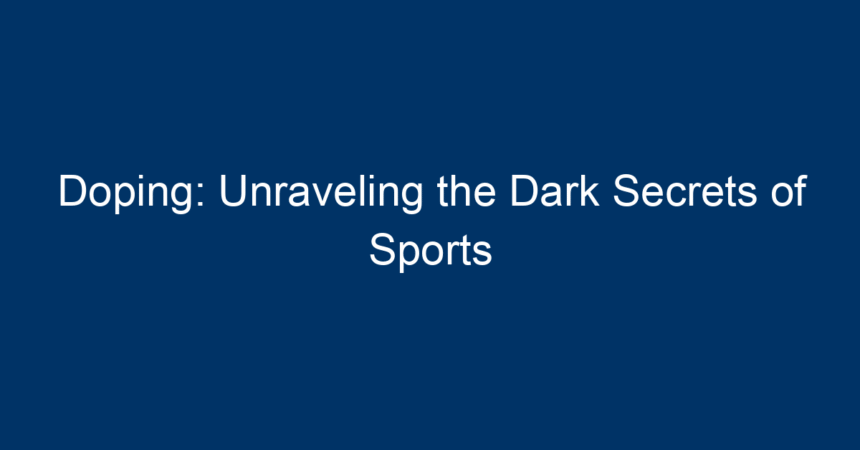Doping has become a pervasive issue in modern sports, clouding the achievements of athletes and raising ethical questions across disciplines. From the adrenaline-fueled glory of the Olympics to the world of professional cycling, the shadow of doping looms large. In this comprehensive article, we will delve into the various facets of doping, unraveling its dark secrets and its impact on athletes, sports organizations, and fans alike.
What is Doping?
Doping refers to the use of banned substances or methods to enhance performance in sports. Governing bodies like the World Anti-Doping Agency (WADA) have strict regulations against doping, emphasizing fairness and integrity. While advances in sports science promise to push physical limits, they also open the door to ethical dilemmas. But what drives an athlete to take such risks, often jeopardizing their careers?
The Allure of Performance Enhancement
The desire to win has always been a fundamental aspect of sports. For many athletes, the pressure to outperform competitors and win accolades can be overwhelming. Here are some reasons why doping might seem appealing:
-
Increased Physical Performance: Many athletes turn to anabolic steroids and other performance-enhancing drugs (PEDs) that promise increased strength, endurance, and recovery.
-
Financial Rewards: Success in sports often translates to lucrative contracts and sponsorship deals. As a result, the financial stakes can push athletes toward doping.
- Psychological Factors: The fear of failure, combined with high expectations from fans and sponsors, can lead athletes to consider doped success as a shortcut.
Types of Doping Substances
Doping encompasses a wide range of substances and techniques. Understanding these can help us better grasp the extent of the problem.
-
Anabolic Steroids: These are among the most common PEDs, designed to promote muscle growth and recovery.
-
Stimulants: Including drugs like amphetamines, these substances enhance energy and alertness, allowing for prolonged performance.
-
Blood Doping: This technique involves increasing the number of red blood cells to improve oxygen delivery throughout the body. Methods include blood transfusions and erythropoietin (EPO) use.
- Hormones: Human growth hormone (HGH) is often abused for its regenerative properties, allowing athletes to recover faster.
The Impact of Doping on Athletes
The implications of doping extend far beyond mere sanctions. Here’s how doping affects athletes personally and professionally:
Health Risks
Despite the short-term benefits, the long-term health risks associated with doping can be severe, including:
-
Cardiovascular Issues: Use of anabolic steroids can lead to heart problems and increased risk of stroke.
- Psychological Effects: Mood swings, aggression, and depression are common when using PEDs.
Career Consequences
Doping can lead to significant career repercussions, including:
-
Suspensions: Upon testing positive, athletes can face bans ranging from months to years.
- Loss of Sponsorships: Endorsements and sponsorship deals often vanish in the wake of a doping scandal.
Reputation Damage
An athlete’s reputation can be irrevocably tarnished by association with doping, potentially affecting their legacy and opportunities post-career.
The Role of Governing Bodies
Sports organizations play a crucial role in combating doping. Initiatives taken by entities such as WADA include:
-
Regular Testing: Implementing unannounced tests to catch doping in real-time.
-
Education Programs: Providing resources and support for athletes to understand the dangers of doping and the importance of clean competition.
- Stricter Penalties: Enhancing penalties for doping violations to deter athletes from considering performance enhancement.
Case Studies: High-Profile Doping Scandals
Several high-profile doping cases have rocked the world of sports and shaped public perception. Let’s examine a couple of prominent examples:
The Lance Armstrong Saga
Lance Armstrong, once a celebrated hero of cycling, was found guilty of systematic doping during his career. His downfall had profound implications, not only for him but for the sport of cycling as a whole, leading to increased scrutiny and reform in anti-doping policies.
The Russian Doping Scandal
The 2014 Sochi Winter Olympics brought forth shocking revelations about state-sponsored doping in Russia. As investigations unfolded, it became clear that many athletes had been complicit, leading to bans and a dark reflection on the integrity of sport itself.
The Psychological Aspect of Doping
Understanding the psychology behind doping helps to address the root causes. Here are some psychological factors influencing doping behavior:
-
Fear of Underperformance: Athletes fear disappointing their teams or coaches, leading to potential doping.
- Social Influence: Peers and role models can significantly impact an athlete’s decision to resort to performance-enhancing drugs.
Solutions and the Path Forward
Combating doping in sports requires a multi-faceted approach. Here are some actionable insights for athletes, coaches, and organizations:
Improve Education
Athletes need robust educational programs that discuss not only the health risks associated with doping but also the ethical implications.
Foster a Supportive Environment
Coaches and teammates should create environments where performance pressure is mitigated and open discussions regarding mental health and wellness are encouraged.
Emphasize Personal Integrity
Athletes should be reminded of the historical significance of integrity in sports, emphasizing that true success is not merely about winning but about how one competes.
Advocate for Policy Changes
Changes in policies and regulations can significantly impact doping prevention efforts. This includes advocating for funding in research to develop better testing methods and further understanding of doping behavior.
Conclusion
Doping is a complex and multifaceted issue that affects not just individual athletes but the entire sports community. By unraveling its dark secrets, we can foster a culture of integrity, health, and ethics in sports. As fans, athletes, and sports enthusiasts, it is our collective responsibility to champion clean competition.
Let us take action by promoting awareness, supporting clean athletes, and demanding accountability from organizations. Together, we can preserve the essence of sports and ensure its future remains bright and fair.




